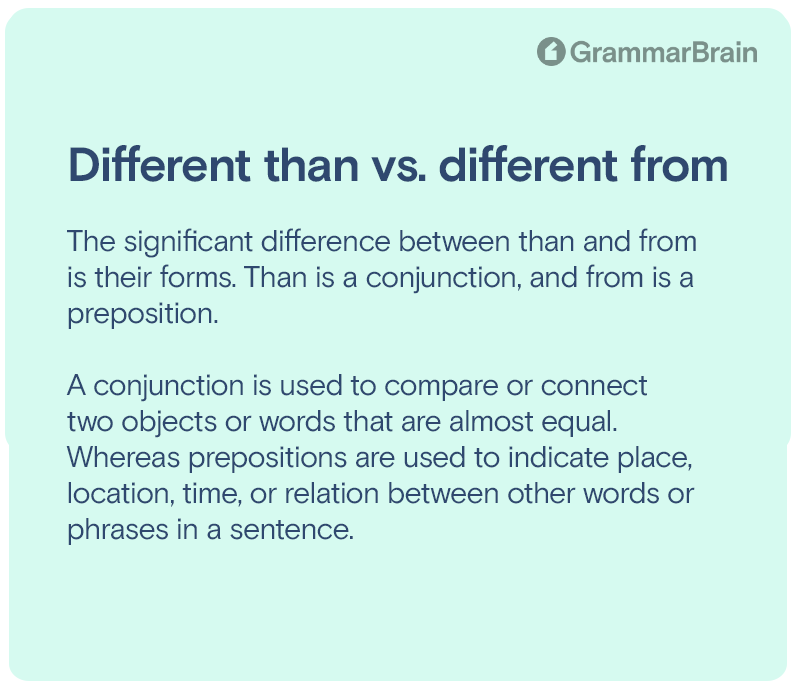Are you confused about whether to use different than or from? You are not alone – many individuals find the use of these conjunctions confusing. To solve the confusion in your mind, we have given an in-depth difference between these two phrases along with explanations.

Is it different from or different than?
When to Use Different Than
Than is a conjunction that connects a sentence’s words, parts, or phrases. However, it can also be used as a preposition in some cases. It then may use to compare the last group of words, people, or things in a sentence.
When to Use Different From
The phrase different from appears in English literature. It’s a preposition and indicates the relation in two words. You can use it in a versatile way as well.
The preposition ‘from’ can also indicate distance or physical differences between two things. The phrase may also denote the cause, sources, or the basis of something.
Since the 1500s, the preposition from has been used with verbs. That’s how we frequently use different in sentences. In the comedy of Errors, William Shakespeare used different from in many sentences.
Examples of “Different Than” in Sentences
- My answers were different than Maria’s.
- Our situation was different than yours.
- Joseph’s kitchen counter is different than ours.
- Your book taste is different than mine.
Different than can also be used as the following:
- John took a different route than Cherry.
- Mia wrote different answers than Jerry in the exam.
- Joseph has a different kitchen than ours.
Examples of “Different From” in Sentences
- Maria is different from her younger sister; she is always into books.
- This apartment is different from the one we used to live in last year.
- The winter this year feels different from the last.
- Shopping at the mall feels different from than streets.
- Anna’s approach to eating at the table was different from Amma’s.
- In some ways, instant noodles are not different from homely-cooked noodles.
- My computer system is not different from Julia’s but hers has more features.
Different than or from are simple ways of presenting or comparing ideas. You can either compare things and write “this is different than that is.” Or you can distinguish them using “this is different from that is.” These are standard ways of comparing or writing sentences.
Each of these phrases are correct and acceptable. However, you might have to choose one of them in particular sentences. Some consider different from an academically correct phrase.
However, not all editors consider it wrong or problematic in sentences.
Conclusion
The significant difference between than and from is their forms. Than is a conjunction, and from is a preposition.
A conjunction is used to compare or connect two objects or words that are almost equal. Whereas prepositions are used to indicate place, location, time, or relation between other words or phrases in a sentence.
Once you understand this, you won’t be confused with different than or from. Both these phrases are correct but in a different contexts.
If these grammatical words are still bothering you, you can use different from in simple sentences. Both these phrases are standard but different than getting more criticism even if it’s purposeful. Writers should use different from in formal writings and research papers.
Inside this article
Fact checked:
Content is rigorously reviewed by a team of qualified and experienced fact checkers. Fact checkers review articles for factual accuracy, relevance, and timeliness. Learn more.
Core lessons
Glossary
- Abstract Noun
- Accusative Case
- Anecdote
- Antonym
- Active Sentence
- Adverb
- Adjective
- Allegory
- Alliteration
- Adjective Clause
- Adjective Phrase
- Ampersand
- Anastrophe
- Adverbial Clause
- Appositive Phrase
- Clause
- Compound Adjective
- Complex Sentence
- Compound Words
- Compound Predicate
- Common Noun
- Comparative Adjective
- Comparative and Superlative
- Compound Noun
- Compound Subject
- Compound Sentence
- Copular Verb
- Collective Noun
- Colloquialism
- Conciseness
- Consonance
- Conditional
- Concrete Noun
- Conjunction
- Conjugation
- Conditional Sentence
- Comma Splice
- Correlative Conjunction
- Coordinating Conjunction
- Coordinate Adjective
- Cumulative Adjective
- Dative Case
- Determiner
- Declarative Sentence
- Declarative Statement
- Direct Object Pronoun
- Direct Object
- Diction
- Diphthong
- Dangling Modifier
- Demonstrative Pronoun
- Demonstrative Adjective
- Direct Characterization
- Definite Article
- Doublespeak
- False Dilemma Fallacy
- Future Perfect Progressive
- Future Simple
- Future Perfect Continuous
- Future Perfect
- First Conditional
- Irregular Adjective
- Irregular Verb
- Imperative Sentence
- Indefinite Article
- Intransitive Verb
- Introductory Phrase
- Indefinite Pronoun
- Indirect Characterization
- Interrogative Sentence
- Intensive Pronoun
- Inanimate Object
- Indefinite Tense
- Infinitive Phrase
- Interjection
- Intensifier
- Infinitive
- Indicative Mood
- Participle
- Parallelism
- Prepositional Phrase
- Past Simple Tense
- Past Continuous Tense
- Past Perfect Tense
- Past Progressive Tense
- Present Simple Tense
- Present Perfect Tense
- Personal Pronoun
- Personification
- Persuasive Writing
- Parallel Structure
- Phrasal Verb
- Predicate Adjective
- Predicate Nominative
- Phonetic Language
- Plural Noun
- Punctuation
- Punctuation Marks
- Preposition
- Preposition of Place
- Parts of Speech
- Possessive Adjective
- Possessive Determiner
- Possessive Case
- Possessive Noun
- Proper Adjective
- Proper Noun
- Present Participle
- Prefix
- Predicate



